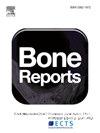Osteoblasts sense extracellular levels of phosphate to control the local expression of phosphatases for matrix mineralisation
IF 2.6
Q3 ENDOCRINOLOGY & METABOLISM
引用次数: 0
Abstract
The provision of inorganic phosphate (Pi) for biomineralisation is under systemic and local control. Locally, osteoblast production of phosphatases such as tissue-nonspecific alkaline phosphatase (TNAP) and PHOSPHO1 is required for normal skeletal mineralisation and osteoblasts may sense extracellular Pi concentrations to control local phosphatase activity and thereby “fine-tune” Pi production and delivery for biomineralisation. This has been poorly explored and this study examined the ability of osteoblasts to sense and respond to extracellular Pi to control the local expression of TNAP and PHOSPHO1.
Extracellular Pi downregulated the expression of PHOSPHO1 and TNAP by human primary osteoblasts at both mRNA and protein levels. Increasing Pi concentrations also reduced the mRNA expression of the type III Na- Pi co-transporters, PiT-1 and PiT-2 and selectively enhanced ERK1/2 phosphorylation. Inhibition of PiT-1 and PiT-2 by Foscarnet or MEK1/2 by UO126 abolished the downregulation of PHOSPHO1 and ALPL expression by extracellular Pi. Moreover, extracellular Pi phosphorylated fibroblast growth factor receptor (FGFR) substrate 2α (FRS2α) and this activation was abolished by Foscarnet. Also, blocking FGFR signalling inhibited the phosphorylation of ERK1/2 and prevented the decrease in ALPL and PHOSPHO1 expression by extracellular Pi. Similar results were observed in cultured murine calvaria. Osteoblast matrix mineralisation by extracellular Pi was dependent upon type III Na- Pi co-transporters and FGFR signalling.
In conclusion, these results suggest an interplay between FGFR and Pi transporters is required for osteoblasts to sense and respond to extracellular Pi. This understanding advances our knowledge of the molecular control of physiological bone mineralisation by osteoblasts.
成骨细胞通过感知细胞外的磷酸盐水平来控制磷酸酶在基质矿化中的局部表达
无机磷酸盐(Pi)的生物矿化是在系统和局部控制下提供的。局部,成骨细胞产生的磷酸酶,如组织非特异性碱性磷酸酶(TNAP)和PHOSPHO1,是正常骨骼矿化所必需的,成骨细胞可以感知细胞外Pi浓度来控制局部磷酸酶活性,从而“微调”Pi的产生和传递,以实现生物矿化。这方面的研究很少,本研究检测了成骨细胞感知和响应细胞外Pi的能力,以控制TNAP和PHOSPHO1的局部表达。胞外Pi在mRNA和蛋白水平上下调人原代成骨细胞PHOSPHO1和TNAP的表达。增加Pi浓度也降低了III型Na- Pi共转运体pit1和pit2的mRNA表达,并选择性地增强了ERK1/2的磷酸化。UO126对Foscarnet或MEK1/2对PiT-1和PiT-2的抑制消除了细胞外Pi对PHOSPHO1和ALPL表达的下调。此外,胞外Pi磷酸化成纤维细胞生长因子受体(FGFR)底物2α (FRS2α),这种激活被Foscarnet消除。此外,阻断FGFR信号传导可抑制ERK1/2的磷酸化,阻止细胞外Pi对ALPL和PHOSPHO1表达的降低。在培养的小鼠颅骨中也观察到类似的结果。细胞外Pi的成骨细胞基质矿化依赖于III型Na- Pi共转运蛋白和FGFR信号传导。总之,这些结果表明,FGFR和Pi转运蛋白之间的相互作用是成骨细胞感知和响应细胞外Pi的必要条件。这种理解促进了我们对成骨细胞生理骨矿化的分子控制的认识。
本文章由计算机程序翻译,如有差异,请以英文原文为准。
求助全文
约1分钟内获得全文
求助全文
来源期刊

Bone Reports
Medicine-Orthopedics and Sports Medicine
CiteScore
4.30
自引率
4.00%
发文量
444
审稿时长
57 days
期刊介绍:
Bone Reports is an interdisciplinary forum for the rapid publication of Original Research Articles and Case Reports across basic, translational and clinical aspects of bone and mineral metabolism. The journal publishes papers that are scientifically sound, with the peer review process focused principally on verifying sound methodologies, and correct data analysis and interpretation. We welcome studies either replicating or failing to replicate a previous study, and null findings. We fulfil a critical and current need to enhance research by publishing reproducibility studies and null findings.
 求助内容:
求助内容: 应助结果提醒方式:
应助结果提醒方式:


